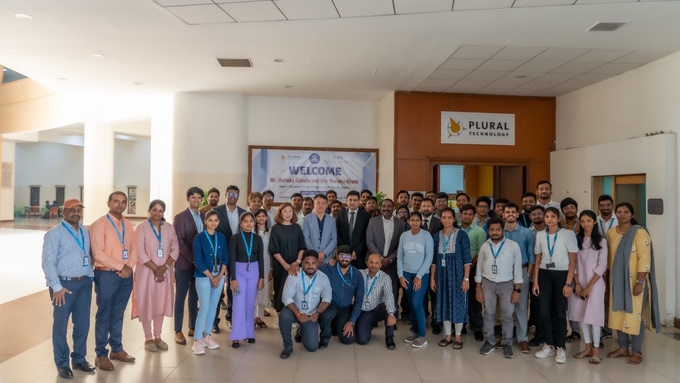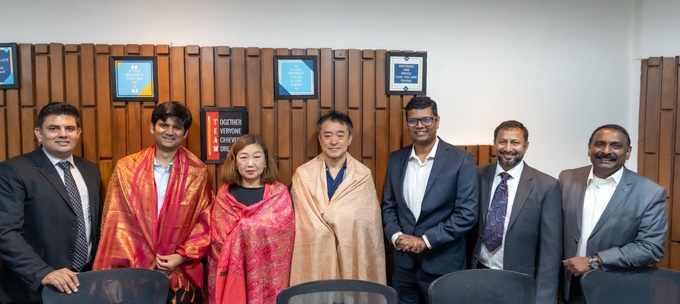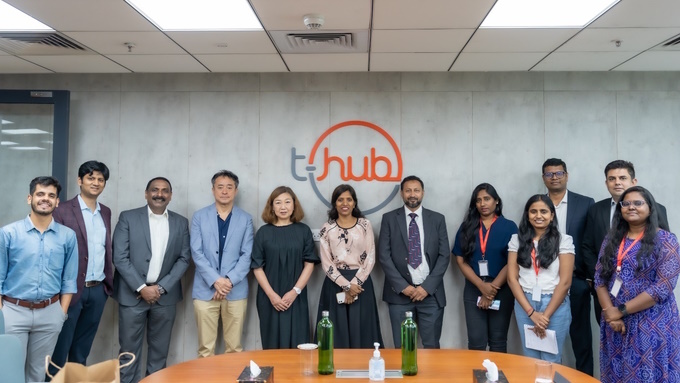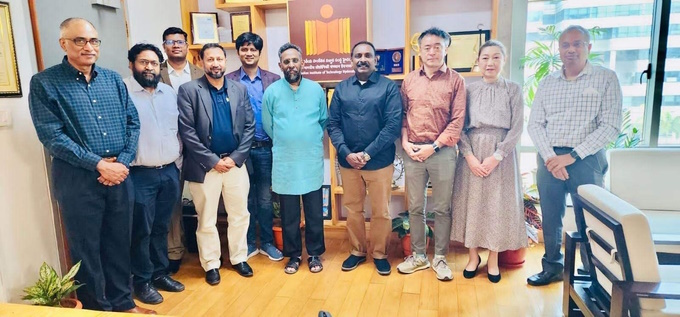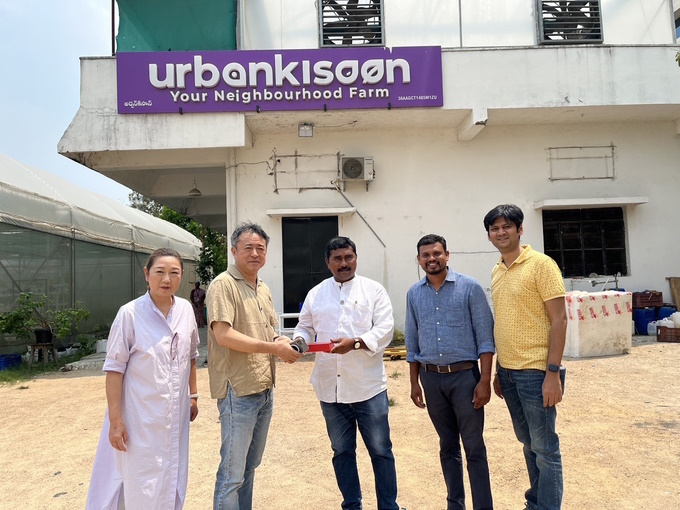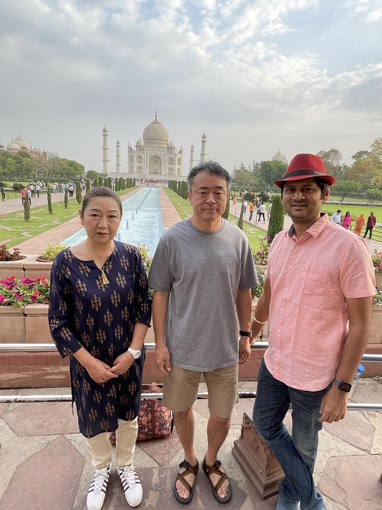- JA
- EN
Visited India from April 10 to 18.
The purpose of this visit was to visit the Pune headquarters and Hyderabad branch of Plural Technology with whom we formed a business alliance in January. The meeting was to understand the IT landscape in India.
On the first day, we visited Plural's Hyderabad office and exchanged greetings with Plural`s staff. We learnt about Indian culture and also introduced Japanese culture to the members of the Plural. We discussed about Plural's service achievements and about ways to proceed PoC for offshore development and future sales strategy.
Later, we visited T-Hub, an IT incubation center and T-Works, a Manufacturing incubation center.
These establishments provided us with conducive environments where we could present our ideas and create prototypes for the PoC.
On the second day, we visited IIT (Indian Institutes of Technology) Hyderabad.
IIT is a top national university with 23 schools in the country, and its alumni include the current CEOs of Google and Microsoft.
First, we visited Professor Kataoka, the only Japanese professor at IIT-H to understand about blockchain-based systems.
Next, we visited three professors and President Muti, who are doing research in the medical field.
In any case, I imagined a sense of innovation welling up in a school culture that is progressive and values diversity.
We then visited the Suzuki Inovation Center where the innovation team identifies local problems and creates prototypes that solve the problems from the ideas. We were shown examples of fish farming which I thought was a wonderful example of free thinking that has nothing to do with automobiles.
★IIT Introduction Video
https://youtu.be/xe3D8ofy8Ug
On the third day, we visited Urban kisaan's Research and Development unit.
Urban Kisaan is a hydroponics startup that has raised funds and is conducting a demonstration experiment on selling vegetables and herbs online as salad bowls and realizing order-to-delivery.
They are comparing the results of cultivation under different conditions such as light with LED lights and with or without wind, and by water, coconut peels, and soil.
Lettuce, okra, eggplant, Brussels sprouts, tomatoes, rice, etc. are grown.
Our company has also started hydroponics in a small way, so it was very helpful and motivated us to continue.
On the fourth day, we visited Plural's Pune headquarters.
Plural gave us a presentation on the IoT system which they are developing.
In addition, we met the administrative departments to discuss the current situation in each other's countries and the characteristics of the company.
We then visited Plural's clients and finally the chairman of the Pushkaraj Group.
A multifaceted group with business locations in 17 countries, serving a variety of manufacturers in the automotive and engineering industries. They are very friendly to Japan and welcomed us warmly despite our sudden visit.
On the last day, we visited Sanoh Industries India (Gurugram) to exchange information on the possibility of introducing PLM.
On Saturday and Sunday, we spent two days sightseeing in NewDelhi and Agra.
New Delhi Tourism
★Qutub Minar
・The tallest minaret in the world, 72.5 meters high
・The steeple and its surrounding architecture built in the 12th century.These are registered on the World Heritage Site in 1993.
・The oldest Islamic monuments in India
<Impression>
The old buildings are still intact and display an atmosphere which resembles Greece!
★Lotus Temple
・Shaped like a lotus flower. It is the last of the seven major Baha'i temples built around the world.
<Impression>
Big scale!
Took off our shoes to worship. But feet were burning.
★Raj Ghat
・A cenotaph is placed as the place where Mahatma Gandhi, the leader of the Indian independence movement was cremated.
・The pedestal is inscribed with Gandhi's last words "Hae Raam" (Oh God!) Gandhi's last words are engraved on the pedestal.
・The National Gandhi Museum is located nearby, displaying personal belongings, study, photo panels, etc.
<Impression>
India gained independence from Britain in 1947, 75 years ago.
Gandhi is famous in Japan, but the leaders of the independence movement are all heroes in India.
★Swaminarayan Akshardham Temple
・Registered in the Guinness World Records as the world's largest Hindu temple
・Stone temples with carvings of plants, animals, and deities are built of sandstone or marble, and no steel or concrete is used in construction.
<Impression>
Big scale!
At night there are also light ups and fountain shows.
Agra Tourism
★Taj Mahal
・Tomb Mausoleum of Mumtaz Mahal, Queen of Shah Jahan, 5th Emperor of the Mughal Empire.
・A typical building of Indo-Islamic culture with total marble, inscribed on the World Heritage Site in 1983.
・Completed in 1653 after 22 years of work by a workforce of 20,000 people, including first-class architects and craftsmen.
<Impression>
The symmetrical garden, the architecture and the beauty of the sculptures were stunning!
Traveled 3 hours from New Delhi to Agra the day before, stayed at a nearby hotel, and visited at 6:00 a.m.
It is scorching 42 degrees during the day, so morning or evening is recommended!
Hindus are the most common religion, followed by Muslims and Sikhs.
Discrimination based on the caste system is prohibited by the Indian Constitution, but its influence still remains in rural areas.
The official language is Hindi, but there are 21 other languages recognized by the Indian Constitution. English has been used in education as a second language since early times.
May is the hottest month in the North Indian plains, with temperatures sometimes exceeding 45°C. Especially from April to June, it is extremely hot. July to September is the rainy season, but it rains heavily for about an hour.
South India is hot all year round, but temperatures vary little throughout the year, with low over 20°C and usually around 30-35°C. The rainy season from June to September brings heavy downpours.
<India's IT industry and innovation are changing dramatically>
Excerpts from a report by Mr. Takeyari, Senior Research, Keio Research Institute at SFC, Keio University
https://gakkai.sfc.keio.ac.jp/journal/.assets/SFCJ21-2-04.pdf
The current scale of India's IT industry has increased from $8 billion in 2000 to $191 billion in 2020, a nearly 24-fold increase. India's nominal GDP has expanded about sixfold over the past 20 years, but its growth has been much faster than that.
About 80% of these orders, or $147 billion, come from overseas. In other words, it is a global business. The corona disaster also continues to expand and is expected to grow to $300-350 billion by 2025.
With the rapid spread of smartphones, digitalization in India is also accelerating.
The background to this is largely due to the existence of the Indian IT industry which is growing by capturing the world's digital technology.Additionally, the emergence of numerous startup companies leveraging smartphone technology, along with the Indian government's "Digital India" policy, has further contributed to this digital revolution. Notably, two initiatives that deserve significant attention are the "Digital ID System - Aadhaar" and "India Stack."
India is a country of unimaginable diversity in culture, religion, language, diet, and wealth. As a result, there are many social issues and problems, and there are many infrastructure and cost constraints to solve them. On the other hand, there are many IT industries that have acquired cutting-edge IT and digital technologies, and a large number of highly skilled IT human resources that support them. Many of them have an entrepreneurial spirit and the number of startup companies is increasing rapidly. Solving problems in India is likely to contribute to solving the problems of the world, especially in other emerging countries, and India is transforming itself into an innovation powerhouse.
「Why the World's Top People Are From India」
https://www3.nhk.or.jp/news/special/international_news_navi/articles/feature/2023/04/25/30980.html
